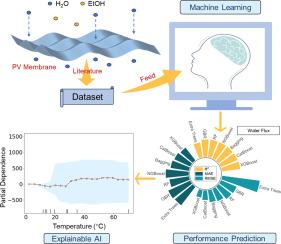An artificial intelligence framework for separation performance prediction of polymeric pervaporation membranes
IF 9.8
1区 工程技术
Q1 ENGINEERING, CHEMICAL
引用次数: 0
Abstract
Pervaporation (PV) is an efficient technology for selective separation of challenging water-based mixtures, which is not feasible by conventional methods such as thermal distillation. Despite its promising application potential, the intricate interactions among various operational parameters and membrane structural characteristics complicate the understanding of the separation processes involved in water–organic mixtures. In this work, we introduce a machine learning (ML)-based predictive framework to forecast the separation performance of polymeric pervaporation membranes in water–ethanol systems through systematically optimizing membrane structures and operating conditions. Through utilizing Shapley additive explanations (SHAP) and partial dependence analysis, the crucial factors influencing separation performance were identified and demonstrated, including membrane effective area, swelling degree, and temperature. Notably, a significant enhancement in separation efficiency was observed when the membrane effective area exceeded 50 cm alongside operational temperature remained between 25 and 40 °C. Our findings demonstrate the dual utility of machine learning in ensuring predictive capability and uncovering the core parameters governing water–ethanol selectivity, establishing fundamental guidelines for rationally designing high-performance pervaporation membranes through parameter optimization.

聚合物渗透蒸发膜分离性能预测的人工智能框架
渗透蒸发(PV)是一种有效的技术,用于选择性分离具有挑战性的水基混合物,这是传统方法(如热蒸馏)无法实现的。尽管其具有广阔的应用前景,但各种操作参数和膜结构特性之间复杂的相互作用使人们对水-有机混合物分离过程的理解复杂化。在这项工作中,我们引入了一个基于机器学习(ML)的预测框架,通过系统地优化膜结构和操作条件来预测水-乙醇体系中聚合物渗透蒸发膜的分离性能。通过Shapley加性解释(SHAP)和部分依赖分析,确定并论证了影响分离性能的关键因素,包括膜有效面积、溶胀度和温度。值得注意的是,当膜的有效面积超过50 cm2,操作温度保持在25 ~ 40℃之间时,分离效率显著提高。我们的研究结果证明了机器学习在确保预测能力和揭示控制水-乙醇选择性的核心参数方面的双重效用,并通过参数优化为合理设计高性能渗透蒸发膜建立了基本准则。
本文章由计算机程序翻译,如有差异,请以英文原文为准。
求助全文
约1分钟内获得全文
求助全文
来源期刊

Desalination
工程技术-工程:化工
CiteScore
14.60
自引率
20.20%
发文量
619
审稿时长
41 days
期刊介绍:
Desalination is a scholarly journal that focuses on the field of desalination materials, processes, and associated technologies. It encompasses a wide range of disciplines and aims to publish exceptional papers in this area.
The journal invites submissions that explicitly revolve around water desalting and its applications to various sources such as seawater, groundwater, and wastewater. It particularly encourages research on diverse desalination methods including thermal, membrane, sorption, and hybrid processes.
By providing a platform for innovative studies, Desalination aims to advance the understanding and development of desalination technologies, promoting sustainable solutions for water scarcity challenges.
 求助内容:
求助内容: 应助结果提醒方式:
应助结果提醒方式:


